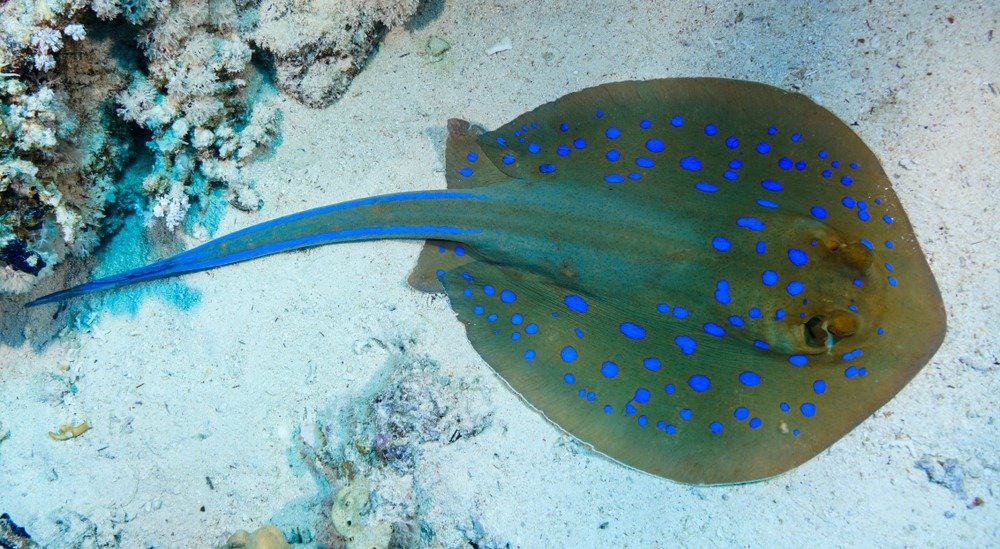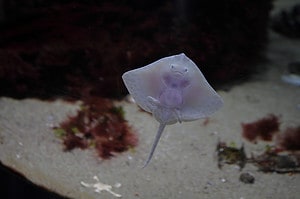Bat rays and stingrays are both cartilaginous fish that are known for their distinctive flat shape and long tail with it’s venomous barb on the end. They both like warm, coastal waters and they both feed on or near the ocean floor. Therefore, it’s not surprising that they are often mistaken for one another. So how do we tell them apart? Well, despite their similarities there are still some key differences between them.
Despite how alike bat rays and other stingrays are, they actually have different shaped pectoral fins and even use them a different way. They also have different shaped snouts and are a different color. But that’s not all there is to learn, so join us as we dive in and discover all of the key differences between bat rays and stingrays.
Comparing Stingray vs Bat Ray

Stingrays are sea rays that consist of eight different family groups. One of the families of stingrays is known as eagle rays, and they are especially notable for having a longer tail than other stingray species. Bat rays are part of the eagle ray family. So today what will be really looking at is how bat rays compare to other stingray species outside eagle rays. With 220 different species of stingrays, this is a very broad comparison!
Check out the chart below to learn a few of the main differences between stingrays and bat rays.
| Stingray | Bat Ray | |
| Location | Widespread | Eastern Pacific Ocean – between Oregon and the Sea of Cortez – and around the Galapagos Islands |
| Habitat | Typically warm, shallow coastal waters | Muddy and sandy estuaries and bays, kelp beds, and close to coral reefs and shorelines |
| Length | Up to 20 feet (check out the world’s largest stingray!) | Up to 13 feet (largest eagle ray) |
| Color | Varies widely | Dark brown or black with white underside |
| Shape | Diamond or disc-shaped. Pectoral fins are rounded at the ends | Diamond-shaped. Pectoral fins pointed at the ends |
| Snout | Fairly rounded, not distinct | Distinct comes to a point |
| Movement | Ripple their bodies like a wave | Flap their wings (pectoral fins) |
| Diet | Crustaceans, shrimp, worms, clams | Crustaceans, mollusks, small fish |
| Predators | Sharks, seals, sea lions, large fish | Sea lions, great white sharks, broadnose sevengill sharks |
| Lifespan | 15 – 25 years | Up to 23 years |
The 4 Key Differences Between Bat Rays and Stingrays
The main difference between stingrays and bat rays is their movement, shape, and habitat. While bat rays live close to the shore mostly along the California and Oregon coastlines, stingrays can be found worldwide in a number of habitats that even include freshwater. In addition, bat rays get their name thanks to their unique shape that resembles bats.
Let’s dive into the major differences between bat rays and other stingrays in more details below.
Bat Ray vs Stingray: Shape

Stingrays are often disc-shaped and their pectoral fins are rounded on the ends
©Mina Ryad/Shutterstock.com
Although both stingrays and bat rays have wide pectoral fins there are some slight differences in their shape. In fact, if you’re wondering where bat rays get their name from then look no further. Bat rays are named because of the shape of their bodies and pectoral fins. They are diamond-shaped and their pectoral fins are pointed on the ends – giving them the appearance of a large bat. Stingrays are typically diamond or disc-shaped but their pectoral fins are rounded on the ends. They also usually have a shorter tail than bat rays.
Bat Ray vs Stingray: Snout

Bat rays swim with a more “graceful” movement like a bird compared to other stingray species.
©Daleen Loest/Shutterstock.com
One of the most distinctive differences between stingrays and bat rays is their snouts. Bat rays have a very distinct snout that protrudes and comes to a point. It is often described as looking like the beak of a bird. Bat rays use their snout to search in the sand for their prey. They can dig trenches up to 8 inches deep in the seabed to expose buried prey. They mainly eat crustaceans, mollusks, and small fish.
Although stingrays are often diamond-shaped, their snout is still fairly rounded and there is no distinct point to it. Stingrays tend to skim along the ocean floor while looking for food which they suck into their mouths before quickly crushing and chewing them. They eat a range of crustaceans, shrimp, worms, and clams.
Bat Ray vs Stingray: Movement

©Claire Brighten/Shutterstock.com
Stingrays and bat rays also use different movements to propel their bodies through the water while swimming. Bat rays get around by flapping their wings (pectoral fins) in a graceful motion just like a bird would. This is also the same type of movement that manta rays use.
Although some stingrays do flap their pectoral fins the same as bat rays while swimming, most use a different method. Most stingrays move their bodies in a rippling motion like a wave to propel themselves forward. They also sometimes use their tail to help manoeuver themselves.
Bat Ray vs Stingray: Habitat

While stingrays live across the world
©aapsky/Shutterstock.com
Finally, the bat ray lives in a relatively small geographic area when compared to other stingrays. They’re found mostly in bays and estuaries along the Oregon, California, and Baja California coasts. They can also be found in the Galapogos islands. Other stingray species have much more varied habitats. The deepwater stingray lives on the continental slope at water depths past 2,000 feet. In fact, there are freshwater stingrays that surpass the size the size of any other known stingrays! The giant (or river) stingray can reach 20 feet in length and weigh up to 490 pounds. The variety of stingrays is truly incredible!
The photo featured at the top of this post is © Claire Brighten/Shutterstock.com
FAQs (Frequently Asked Questions)
Are bat rays and stingrays from the same class?
Yes, both bat rays and stingrays are members of the class Chondrichthyes which is the class of cartilaginous fish. Cartilaginous fish are fish that have a skeleton that is made from cartilage rather than bone. Both bat rays and stingrays are also members of the subclass Elasmobranchii which includes all sharks, rays, skates, and sawfish.
Are bat rays dangerous?
Although bat rays, like most stingrays, have a venomous barb on their tail they are not considered to be particularly dangerous as they only use it when they are attacked or are frightened.
Are stingrays dangerous?
Although the word “sting” in their name can be quite offputting, and they do seem to have a bad reputation as they can be dangerous, on the whole stingrays are peaceful animals. Like any animal, they can react badly if they are frightened or provoked (or stepped on), but they usually only use the venomous barb on their tail as a defense mechanism in those situations. However, in some cases, fatalities do occur.
Thank you for reading! Have some feedback for us? Contact the AZ Animals editorial team.







